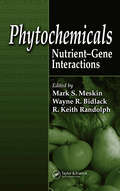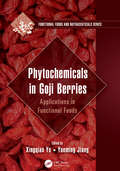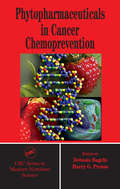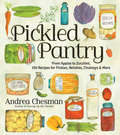- Table View
- List View
Phytochemicals: Nutrient-Gene Interactions
by Mark S. Meskin Wayne R. Bidlack R. Keith RandolphUnderstanding phytochemical-gene interactions provides the basis for individualized therapies to promote health as well as prevent and treat disease. The authors of Phytochemicals: Nutrient-Gene Interactions examine the interactions between phytochemicals and the human genome and discuss the impact these interactions have on health, aging, a
Phytochemicals: Mechanisms of Action
by Mark S. Meskin Audra J. Davies Douglas S. Lewis R. Keith Randolph Wayne R. BidlackPhytochemicals: Mechanisms of Action is the latest volume in a highly regarded series that addresses the roles of phytochemicals in disease prevention and health promotion. The text, an ideal tool for scientists and researchers in the fields of functional foods and nutraceuticals, links diets rich in plant-derived compounds, such as fruit, vegetabl
Phytochemicals in Food and Health: Perspectives for Research and Technological Development
by Deepak Kumar Verma; Mamta ThakurThis volume brings together information on the available and newly emerging technologies related to using plant compounds that have a beneficial role in food production. It is divided into sections focusing on phytochemistry of cereals and legumes, phytochemistry of medicinal plants, and technological advances in phytochemical study. Topics include the role of anti-nutritional substances of legumes in human health and on the elimination of such through technological processing sorghum phytochemicals and their processing and use in the development of food products production of nutraceuticals and functional foods of pharmaceutical importance T. cordifolia in the development of its therapeutic use in the food, health, and pharmacology industries polyphenolic compounds of plants, including their biosynthesis process, their classification, function, and role as bioactive compounds
Phytochemicals in Food and Health: Perspectives for Research and Technological Development
by Deepak Kumar Verma Mamta ThakurThis volume brings together information on the available and newly emerging technologies related to using plant compounds that have a beneficial role in food production. It is divided into sections focusing on phytochemistry of cereals and legumes, phytochemistry of medicinal plants, and technological advances in phytochemical study. Topics include the role of anti-nutritional substances of legumes in human health and on the elimination of such through technological processing sorghum phytochemicals and their processing and use in the development of food products production of nutraceuticals and functional foods of pharmaceutical importance T. cordifolia in the development of its therapeutic use in the food, health, and pharmacology industries polyphenolic compounds of plants, including their biosynthesis process, their classification, function, and role as bioactive compounds
Phytochemicals in Fruits and their Therapeutic Properties
by C.K. NarayanaThe book provides facts of fruits and their role in curing of diseases with cell line or animal studies and their pharmacological evidence would help the readers to understand the subject in greater depth. It provides information on the subject and will help researchers to carry the interest forward. The book links the traditional knowledge available on each fruit crop regarding their curative properties and the information on their scientific validation. The contents have been organized crop wise in a logical sequence, with references been provided at the end of each chapter for further reading and better understanding of the subject.The book will help the students/ researchers/ scientists and common man alike to look at the fruits as protective foods not just because it is said so, but with a scientific explanation.Note: T&F does not sell or distribute the hardback in India, Pakistan, Nepal, Bhutan, Bangladesh and Sri Lanka. This title is co-published with NIPA.
Phytochemicals in Fruits and their Therapeutic Properties
by C.K. NarayanaThe book provides facts of fruits and their role in curing of diseases with cell line or animal studies and their pharmacological evidence would help the readers to understand the subject in greater depth. It provides information on the subject and will help researchers to carry the interest forward. The book links the traditional knowledge available on each fruit crop regarding their curative properties and the information on their scientific validation. The contents have been organized crop wise in a logical sequence, with references been provided at the end of each chapter for further reading and better understanding of the subject.The book will help the students/ researchers/ scientists and common man alike to look at the fruits as protective foods not just because it is said so, but with a scientific explanation.Note: T&F does not sell or distribute the hardback in India, Pakistan, Nepal, Bhutan, Bangladesh and Sri Lanka. This title is co-published with NIPA.
Phytochemicals in Goji Berries: Applications in Functional Foods (Functional Foods and Nutraceuticals)
by Xingqian Ye and Yueming JiangGoji berries (Lycium barbarum), which are widely distributed in Northwestern China, Southeastern Europe and the Mediterranean areas, have traditionally been employed in Chinese medicine from ancient times. Goji berries, also known as wolfberry, have become increasingly popular in the Western world because of their nutritional properties, often advertised as a superfood in Europe and North America. With the development of analysis methods, various chemical constituents have been identified, including carbohydrates, carotenoids, flavonoids, betaine, cerebroside, -sitosterol, amino acids, trace elements, vitamins and other constituents. Polysaccharides have been identified as one of the major active ingredients responsible for biological activities. Phytochemicals in Goji Berries: Applications in Functional Foods, a volume in the Functional Foods and Nutraceuticals Series, provides information about the chemical, biochemical, botanic properties, bioactive components and health benefits of Goji berries. It also discusses postharvest storage technology, processing technology, and the development and utilization of Goji berry by-products in medicinal foods and functional foods, as well as addressing food safety issues. Features: Provide information on Goji fruit origin and growing conditions, distribution, and biochemical properties Discusses such medicinal properties and health benefits of Goji berries as the capacity to lower blood pressure, treat anemia, maintain cholesterol levels in the normal range and decrease risk of cardiovascular disease. Additionally, Goji berries have anti-inflammatory and anti-tumor properties, among others Includes information on traditional products, new products and innovative processing technologies This book will serve college and university students majoring in food science, nutrition, pharmaceutical science, and botanical science. It also will serve as a unique reference for food science professionals pursuing functional foods, marketing expansion, as well as nutritional dietary management. Readers will obtain sound scientific knowledge of the nutritional value and health benefits of the different Goji berry products such as juice, cake, soup, snacks, and medicinal foods. Also available in the Functional Foods and Nutraceuticals series: Korean Functional Foods: Composition, Processing and Health Benefits, edited by Kun-Young Park, Dae Young Kwon, Ki Won Lee, Sunmin Park (ISBN 978-1-4987-9965-2) Phytochemicals in Citrus: Applications in Functional Foods, edited by Xingqian Ye (ISBN 978-1-4987-4272-6) Food as Medicine: Functional Food Plants of Africa, by Maurice M. Iwu (ISBN 978-1-4987-0609-4) For a complete list of books in the series, please visit our website at https://www.crcpress.com/Functional-Foods-and-Nutraceuticals/book-series/CRCFUNFOONUT
Phytochemicals in Goji Berries: Applications in Functional Foods (Functional Foods and Nutraceuticals)
by Xingqian Ye Yueming JiangGoji berries (Lycium barbarum), which are widely distributed in Northwestern China, Southeastern Europe and the Mediterranean areas, have traditionally been employed in Chinese medicine from ancient times. Goji berries, also known as wolfberry, have become increasingly popular in the Western world because of their nutritional properties, often advertised as a superfood in Europe and North America. With the development of analysis methods, various chemical constituents have been identified, including carbohydrates, carotenoids, flavonoids, betaine, cerebroside, -sitosterol, amino acids, trace elements, vitamins and other constituents. Polysaccharides have been identified as one of the major active ingredients responsible for biological activities. Phytochemicals in Goji Berries: Applications in Functional Foods, a volume in the Functional Foods and Nutraceuticals Series, provides information about the chemical, biochemical, botanic properties, bioactive components and health benefits of Goji berries. It also discusses postharvest storage technology, processing technology, and the development and utilization of Goji berry by-products in medicinal foods and functional foods, as well as addressing food safety issues. Features: Provide information on Goji fruit origin and growing conditions, distribution, and biochemical properties Discusses such medicinal properties and health benefits of Goji berries as the capacity to lower blood pressure, treat anemia, maintain cholesterol levels in the normal range and decrease risk of cardiovascular disease. Additionally, Goji berries have anti-inflammatory and anti-tumor properties, among others Includes information on traditional products, new products and innovative processing technologies This book will serve college and university students majoring in food science, nutrition, pharmaceutical science, and botanical science. It also will serve as a unique reference for food science professionals pursuing functional foods, marketing expansion, as well as nutritional dietary management. Readers will obtain sound scientific knowledge of the nutritional value and health benefits of the different Goji berry products such as juice, cake, soup, snacks, and medicinal foods. Also available in the Functional Foods and Nutraceuticals series: Korean Functional Foods: Composition, Processing and Health Benefits, edited by Kun-Young Park, Dae Young Kwon, Ki Won Lee, Sunmin Park (ISBN 978-1-4987-9965-2) Phytochemicals in Citrus: Applications in Functional Foods, edited by Xingqian Ye (ISBN 978-1-4987-4272-6) Food as Medicine: Functional Food Plants of Africa, by Maurice M. Iwu (ISBN 978-1-4987-0609-4) For a complete list of books in the series, please visit our website at https://www.crcpress.com/Functional-Foods-and-Nutraceuticals/book-series/CRCFUNFOONUT
Phytochemicals in Health and Disease (Oxidative Stress And Disease Ser. #Vol. 12)
by Yongping Bao Roger Fenwick"� well-written and the content is clearly presented. � There are plentiful figures and tables, which are effectively labeled and adequately support the content. �highly recommended for academic and special libraries. �effectively presents current research on phytochemicals in a readable manner."- E-Streams "This landmark volume shows h
Phytochemicals in Health and Disease
by Yongping Bao Roger Fenwick"� well-written and the content is clearly presented. � There are plentiful figures and tables, which are effectively labeled and adequately support the content. �highly recommended for academic and special libraries. �effectively presents current research on phytochemicals in a readable manner."- E-Streams "This landmark volume shows h
Phytochemicals in Vegetables and their Therapeutic Properties
by C.K NarayanaThis book contains information on plant-based nutrients and phytochemicals in vegetable crops that are commonly consumed. The information generated by researchers using modern methods of biochemical analysis and results, mostly validated using cell line cultures or animal models, and to a limited extent on human volunteers have been presented. The vegetable crops have been grouped based on the family they belong to, because most often members of the same family have similar biomolecules as active ingredients and have similar effects on health. The book will help students/researchers/scientists and common man alike to look at the vegetables as protective foods, not just because it is said so, but with a scientific explanation.Note: T&F does not sell or distribute the hardback in India, Pakistan, Nepal, Bhutan, Bangladesh and Sri Lanka. This title is co-published with NIPA.
Phytochemicals in Vegetables and their Therapeutic Properties
by C.K NarayanaThis book contains information on plant-based nutrients and phytochemicals in vegetable crops that are commonly consumed. The information generated by researchers using modern methods of biochemical analysis and results, mostly validated using cell line cultures or animal models, and to a limited extent on human volunteers have been presented. The vegetable crops have been grouped based on the family they belong to, because most often members of the same family have similar biomolecules as active ingredients and have similar effects on health. The book will help students/researchers/scientists and common man alike to look at the vegetables as protective foods, not just because it is said so, but with a scientific explanation.Note: T&F does not sell or distribute the hardback in India, Pakistan, Nepal, Bhutan, Bangladesh and Sri Lanka. This title is co-published with NIPA.
Phytochemicals of Nutraceutical Importance
by Dhan Prakash Girish SharmaNutraceuticals are bioactive phytochemicals that protect or promote health and occur at the intersection of food and pharmaceutical industries. This book covers a wide spectrum of human health and diseases, including the role of phytonutrients in the prevention and treatment. It also reviews biological and clinical effect, molecular level approach, quality assurance, bioavailability and metabolism of a number phytochemicals, and their role to combat different diseases.
Phytopharmaceuticals and Biotechnology of Herbal Plants (Exploring Medicinal Plants)
by Sachidanand Singh Rahul Datta Parul Johri Mala TrivediPlant-based drugs play an important role in all cultures and have been crucial in maintaining health and fighting diseases, and by using contemporary methods of biotechnology, plants with explicit chemical compositions are propagated and genetically upgraded for the mining of pharmaceuticals. Phytopharmaceuticals and Biotechnology of Herbal Plants presents the latest advances in the development of transgenic plants, covering phototherapeutics, secondary metabolite production, metabolomics, metabolic engineering, bioinformatics, quality control of herbal plant products, crop improvement using various breeding techniques, tissue culture techniques, and the future of phytopharmaceuticals. Features: Describes developments and applications of phytopharmaceuticals of herbal plants. Highlights the importance of phytopharmaceutical of plants and potential applications in the food and pharma industries. Provides an overview of research on key anticancer drugs to elucidate the biotechnological approaches for their production in cell cultures. Places special emphasis on the biosynthetic pathway mapping and metabolic engineering. Phytopharmaceuticals and Biotechnology of Herbal Plants will be an invaluable resource to academics and researchers associated with plant science, herbal drug manufacturers, and phytochemists.
Phytopharmaceuticals and Biotechnology of Herbal Plants (Exploring Medicinal Plants)
by Sachidanand Singh Rahul Datta Parul Johri Mala TrivediPlant-based drugs play an important role in all cultures and have been crucial in maintaining health and fighting diseases, and by using contemporary methods of biotechnology, plants with explicit chemical compositions are propagated and genetically upgraded for the mining of pharmaceuticals. Phytopharmaceuticals and Biotechnology of Herbal Plants presents the latest advances in the development of transgenic plants, covering phototherapeutics, secondary metabolite production, metabolomics, metabolic engineering, bioinformatics, quality control of herbal plant products, crop improvement using various breeding techniques, tissue culture techniques, and the future of phytopharmaceuticals. Features: Describes developments and applications of phytopharmaceuticals of herbal plants. Highlights the importance of phytopharmaceutical of plants and potential applications in the food and pharma industries. Provides an overview of research on key anticancer drugs to elucidate the biotechnological approaches for their production in cell cultures. Places special emphasis on the biosynthetic pathway mapping and metabolic engineering. Phytopharmaceuticals and Biotechnology of Herbal Plants will be an invaluable resource to academics and researchers associated with plant science, herbal drug manufacturers, and phytochemists.
Phytopharmaceuticals for Brain Health
by Shahnaz Subhan Manashi BagchiResearch studies demonstrate diet and proper nutrition in conjunction with cognitive, mental, social, and physical activities can significantly help in improving brain health with advancing age, and potentially reduce the risk of cognitive decline. These studies of phytopharmaceuticals and medicinal plants, demonstrate the efficacy of Huperzine A, berry anthocyanins, trans-resveratrol, Ginkgo biloba, Bacopa monniera, Centella asiatica, tocotrienols, and palm oil in boosting brain health and physical well-being. In addition, consumption of marine fishes and general seafood is recommended for long-term nutritional intervention to preserve mental health, hinder neurodegenerative processes, and sustain cognitive capacities in humans. Omega-3 and omega-6 polyunsaturated fatty acids, n-3/n-6 PUFAs, flavonoids, and antioxidants prevent the initiation and progression of many neurological disorders. This book is a comprehensive review of phytopharmaceuticals impacting brain health with emphasis on diverse applications in food and nutrition sciences, biomedicine, neurology and other scientific and medical fields. It details available methods and contains numerous references making this the perfect guide for scientists who want to explore the fascinating world of phytopharmaceuticals with relation to brain health. Phytopharmaceuticals for Brain Health appeals to a diverse range of readers in industry, medical doctors, research and academia, including biologists, biochemists, food scientists, nutritionists and health professionals. Overall, this book brings a classic scenario of neurological problems to possible amelioration using novel nutraceuticals and functional foods.
Phytopharmaceuticals for Brain Health
by Shahnaz Subhan Manashi BagchiResearch studies demonstrate diet and proper nutrition in conjunction with cognitive, mental, social, and physical activities can significantly help in improving brain health with advancing age, and potentially reduce the risk of cognitive decline. These studies of phytopharmaceuticals and medicinal plants, demonstrate the efficacy of Huperzine A, berry anthocyanins, trans-resveratrol, Ginkgo biloba, Bacopa monniera, Centella asiatica, tocotrienols, and palm oil in boosting brain health and physical well-being. In addition, consumption of marine fishes and general seafood is recommended for long-term nutritional intervention to preserve mental health, hinder neurodegenerative processes, and sustain cognitive capacities in humans. Omega-3 and omega-6 polyunsaturated fatty acids, n-3/n-6 PUFAs, flavonoids, and antioxidants prevent the initiation and progression of many neurological disorders. This book is a comprehensive review of phytopharmaceuticals impacting brain health with emphasis on diverse applications in food and nutrition sciences, biomedicine, neurology and other scientific and medical fields. It details available methods and contains numerous references making this the perfect guide for scientists who want to explore the fascinating world of phytopharmaceuticals with relation to brain health. Phytopharmaceuticals for Brain Health appeals to a diverse range of readers in industry, medical doctors, research and academia, including biologists, biochemists, food scientists, nutritionists and health professionals. Overall, this book brings a classic scenario of neurological problems to possible amelioration using novel nutraceuticals and functional foods.
Phytopharmaceuticals in Cancer Chemoprevention
by Debasis Bagchi Harry G. PreussDuring the past decade, a significant amount of research has been conducted on phytopharmaceuticals. Today, a growing body of evidence demonstrates the efficacy of a wide variety of natural products and affirms their potential in the treatment of cancer. Phytopharmaceuticals in Cancer Chemoprevention focuses on the role of natural supplemen
Phytoremediation in Food Safety: Risks and Prospects
by Naga Raju Maddela Sesan Abiodun AransiolaPhytoremediation is the process that uses plants to remove pollutants from soils. These pollutants are stored in the edible parts of plants and, if they are consumed above a certain level, they become a health risk for humans and animals. This book is a critical review of phytoremediation, its direct or indirect effects on food products, and the risks posed by this cost-effective technology in food safety. It shows how different plants are suited for phytoremediation, explains the role of toxicants in the environment, and analyses their effects and risks in the food chain at a global level. It also reviews the extraction methods of toxicants from plants after they are exposed to phytoremediation.Features: Summarizes the phytoremediation technology for effective remediation Describes different types of pollutants in soils that render food products useless Identifies the role of phytoremediation in the environment and its advantages and disadvantages Explains the role of phytoexclusion and phytostabilization in foods and food safety Includes many case studies to describe the extraction protocols in postharvest for food safety This book is intended for practitioners in public and private companies involved in soil remediation and food production, as well as graduate students and academics, in both developed and developing countries, who are involved in soil and environmental sciences, the food industry, agriculture, and biotechnology.
Phytoremediation in Food Safety: Risks and Prospects
Phytoremediation is the process that uses plants to remove pollutants from soils. These pollutants are stored in the edible parts of plants and, if they are consumed above a certain level, they become a health risk for humans and animals. This book is a critical review of phytoremediation, its direct or indirect effects on food products, and the risks posed by this cost-effective technology in food safety. It shows how different plants are suited for phytoremediation, explains the role of toxicants in the environment, and analyses their effects and risks in the food chain at a global level. It also reviews the extraction methods of toxicants from plants after they are exposed to phytoremediation.Features: Summarizes the phytoremediation technology for effective remediation Describes different types of pollutants in soils that render food products useless Identifies the role of phytoremediation in the environment and its advantages and disadvantages Explains the role of phytoexclusion and phytostabilization in foods and food safety Includes many case studies to describe the extraction protocols in postharvest for food safety This book is intended for practitioners in public and private companies involved in soil remediation and food production, as well as graduate students and academics, in both developed and developing countries, who are involved in soil and environmental sciences, the food industry, agriculture, and biotechnology.
Phytotechnology: A Sustainable Platform for the Development of Herbal Products (Urbanization, Industrialization, and the Environment)
by Wanderley Pereira OliveiraHerbal products have traditionally been used in several industrial sectors and have gained a notable reputation in recent years due to the current trend in society, which seeks natural, healthier, and more sustainable products. The processing of these products, however, is multiplex but important for the production of a high-quality standardised product. Phytotechnology: A Sustainable Platform for the Development of Herbal Products highlights the complex, multidisciplinary process of phytopharmaceutical technology used to create herbal remedies. Organised into four parts, various experts in the field clearly and objectively address the fundamental and technological concepts involved in the manufacturing of high-quality herbal products. Additional Features Emphasises how herbal products have traditionally been used in several industrial sectors, including pharmaceutical science, food, cosmetics, chemical engineering, and agroindustry Provides a much-needed update of the current information regarding phytopharmaceutical technology and focuses on industrial applications Written using a multidisciplinary approach, to include all subjects involved in the processing of herbal products The information presented is valuable reference material for professionals of different specialties who wish to enter this fascinating and innovative area.
Phytotechnology: A Sustainable Platform for the Development of Herbal Products (Urbanization, Industrialization, and the Environment)
by Wanderley Pereira OliveiraHerbal products have traditionally been used in several industrial sectors and have gained a notable reputation in recent years due to the current trend in society, which seeks natural, healthier, and more sustainable products. The processing of these products, however, is multiplex but important for the production of a high-quality standardised product. Phytotechnology: A Sustainable Platform for the Development of Herbal Products highlights the complex, multidisciplinary process of phytopharmaceutical technology used to create herbal remedies. Organised into four parts, various experts in the field clearly and objectively address the fundamental and technological concepts involved in the manufacturing of high-quality herbal products. Additional Features Emphasises how herbal products have traditionally been used in several industrial sectors, including pharmaceutical science, food, cosmetics, chemical engineering, and agroindustry Provides a much-needed update of the current information regarding phytopharmaceutical technology and focuses on industrial applications Written using a multidisciplinary approach, to include all subjects involved in the processing of herbal products The information presented is valuable reference material for professionals of different specialties who wish to enter this fascinating and innovative area.
The Pickled Pantry: From Apples to Zucchini, 150 Recipes for Pickles, Relishes, Chutneys & More
by Andrea ChesmanBlending your grandmother&’s pickling know-how with today&’s Internet resources, Andrea Chesman shows you how easy it is to fill your pantry with tasty homemade sauerkraut, Salt-Cured Dilly Beans, and Rosemary Onion Confit. Explaining classic techniques in simple language, guiding you to helpful websites, and making you laugh with humorous stories, Chesman provides inspiration and encouragement for both first-time picklers and dedicated home canners. With tips on pickling everything from apples to zucchini, you&’ll enjoy exploring the stunning variety of flavors that can fill a Mason jar.
Picklehead: From Ceylon to suburbia; a memoir of food, family and finding yourself
by Rohan CandappaRohan Candappa, author of bestselling humour books such as the Little Book of Stress and The Curious Incident of the Weapons of Mass Destruction, is the son of a Sri Lankan father and Burmese mother. He grew up small and round in South London, riding his chopper bike and supporting Leeds United. But every day his mother would conjur delicious meals out of thin air. His father cooked too, with fiery flavourings, black curries and green coriander chutneys. Their home became the focus for family gatherings and feasts of such delicacy and exoticism that you'd never have known Norwood lay outside the window.Yet somewhere in his twenties Rohan forgot his culinary heritage and it wasn't until he was bringing up his own young family that he began to think more about his identity as a second generation immigrant and the binding, identifying power of the family meal caught his imagination.And so he began this beautifully written, funny, poignant memoir of his heritage and his home. Of curry leaves and curried chips. Hot chillis and hot dogs. Pataks and Heinz. About the past and the present - and the place where time should cease to matter... the family kitchen.
Pickles & Relishes: From apples to zucchini, 150 recipes for preserving the harvest (Storey Country Wisdom Bulletin Ser.)
by Andrea ChesmanThese 150 quick-and-easy recipes turn bumper crops into mouthwatering pickles and relishes, using little or no salt. All techniques meet current USDA guidelines.















